Symbolism Art – Development of the Symbolist Movement
What is Symbolism in art? If you are familiar with the exploration of spirituality, idealism, and poetry in your art practice, then you would enjoy learning about the Symbolist movement. The Symbolism movement originated in the late 19th century through literature and poetry that promoted an idealistic view of reality as opposed to the stark and bitter parts of it. This included an emphasis on metaphors and other linguistic devices as a revolt against Realism and Naturalism. In this article, we will introduce you to the Symbolism movement and dive into how the movement emerged, a few key artists who used Symbolism in painting, and some famous Symbolism art examples that shed light on the important themes of the global movement. Read on for more about the imaginative world of Symbolism!
The Symbolism Movement: What Is Symbolism?
When forming a Symbolism art definition, it is important to understand the basis of the term “Symbolism” as well as the influences of the culture behind it. You may be familiar with the emojis and icons available on your smartphone, which is a derivative element of the original notion of the symbol, which many of us understand as an image or motif that represents a concept, idea, or abstract theme. The word “symbol” originated from the Latin terms symbolum and symbolus, with the latter term referring to a sign or token of recognition. It was derived from the Greek syn (together) + bole (to cast/throw), evolving in meaning to refer to the act of comparing things to determine authenticity, before reaching its current usage of referring to a thing designed to represent another in the 16h century by Edmund Spenser in The Faerie Queene.

Symbols can take shape in many different visual forms and art, they play a significant role in relaying the artist’s intended message about the artwork. You may have heard of the term Symbolism in art, which refers to an art movement of the late 19th century that was inspired by a collective rejection of the art styles and concepts of Realism and Naturalism in art.
The foundations of Symbolism in art were built on a Romantic outlook and privileged idealistic views and metaphors to describe daily life. The Symbolism movement favored poetry and literature giants such as Charles Baudelaire and Edgar Allen Poe whose literary contributions to the movement inspired many artists to pursue the idealistic route.
A Symbolism art definition also encompasses the influence of poetry, spirituality, and creative imagination as the premise of an artwork or poem. Another interesting element that artists who used Symbolism in their art include a priority on the evocation of feeling to relay the soul of the poet or artist as opposed to simply representing, narrating, or describing a subject. Some of the most famous Modern artists who used Symbolism included artists such as Paul Gauguin, Gustave Moreau, Vincent van Gogh, and Pierre Puvis de Chavannes.

Key Influences in the Symbolism Movement
The use of symbols in art was also seen in the Decadent movement, which is often mistaken for the Symbolist movement, and was founded on principles that focused on artificiality and excess. The Decadent movement was a late 19th-century movement that acquired its name from art critics who deemed the works of creative writers as self-indulgent and bordering on an obsession with taboo subjects. Below, we will explore some of the key influences of Symbolism, which will help strengthen your understanding of the context of the movement.
Les Fleurs Du Mal (1857) by Charles Baudelaire
Charles Pierre Baudelaire was a popular French poet, translator, essayist, and art critic, who was well-respected and celebrated for his expert pen in balancing rhyme and rhythm in poetry. His works were inspired by moments from his everyday life with his best-known work being Les Fleurs Du Mal (1857), which translates in English to The Flowers of Evil. The volume of poetry was published in the mid-19th century and touched on the shifting nature of beauty during Parisian industrialization. Baudelaire specialized in prose-poetry and is recognized as the man who invented the term “modernity”. Charles Baudelaire remains an important figure to the rest of art history to follow since his words went on to influence not only the Symbolists but also other poetry giants such as Arthur Rimbaud and Paul Verlaine.
Baudelaire also touched on the responsibility of the artist who was bound to capture the nature of urbanization, characterized by an ephemeral experience and “fleeting” moments within a rapidly changing environment.
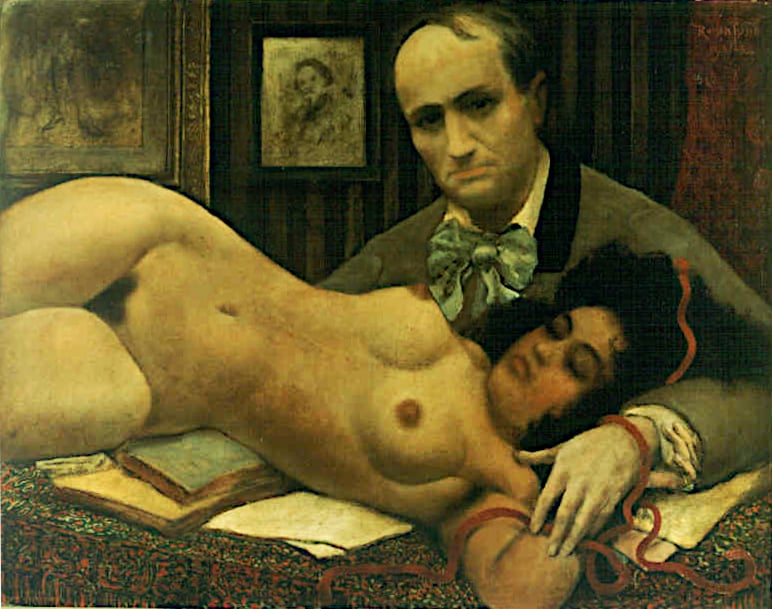
When Les Fleurs Du Mal was first published, a few of Baudelaire’s poems were censored due to critics deeming them immoral, yet today, it is regarded as one of the major literary works of French poetry. Some of the key themes from the book, also seen in Symbolism, included themes of eroticism, decadence, suffering and sin, obsessions with death, the pursuit of idealism, and a hatred of evil and the self. The book is made up of six sections: Spleen and Ideal, Parisian Scenes, Wine, Flowers of Evil, Revolt, and Death. Baudelaire’s section on the urban lifestyle and scenes of Paris were particularly influential to the French Modernist era and reflected his feelings on modernization.
Baudelaire traversed themes of anonymity that occur in the city and the alienating nature of the clean geometry in the layout of the city. Baudelaire also included the “unsung heroes” of Paris, identified by figures in society who were often overlooked such as the industrial worker, the beggar, the prostitute, and the elderly among many other archetypes of 19th century Western-European reality.
Baudelaire offered a vital critique through poetry on the cost of modernity. Les Fleurs Du Mal was a nostalgic encounter with a rapidly modernizing city that the author was grappling to reconcile with. Charles Baudelaire also translated many of Edgar Allen Poe’s works and drew from his poems to create new tropes that would later be adopted by Symbolists.
Parnassianism
Parnassianism refers to a literary style that occurred during the positivist period in the 19th century just before the emergence of Symbolism. The term derives from the literary journal Le Parnasse Contemporain (1866-1876), named for Mount Parnassus, the traditional home of the Muses in Greek mythology. You may have come across the term “art for art’s sake”, which was penned by literary creative Théophile Gautier, admired by a number of Symbolists.

Symbolism retained the notion of wordplay from Parnassianism while combining other influences from Hermeticism, which gave rise to a modern form of poetry known as freer versification or “free poetry”.
Hermeticism was driven by philosophies derived from texts attributed to a mythic figure known as Hermes Trismegistus. It was a spiritualist movement based on notions of occult knowledge available only to an ancient elect, of a primeval divinity on whom all subsequent notions of “God” was based. Symbolism combined it with Parnassianism’s atmosphere of “ironic detachment”. Parnassianism was aimed at faultless and precise works that echoed a sense of detachment and focused on Neoclassical and exotic subjects.
The Symbolist Manifesto (1886) by Jean Moréas
A symbolist manifesto was published in 1886 by Jean Moréas in the French newspaper Le Figaro and outlined the three main figures of Symbolism, which covered Charles Baudelaire, Paul Verlaine, and Stéphane Mallarmé as the pioneering poets of the movement. Moréas also made clear the purpose of Symbolism rooted in the intention to express an ideal as opposed to settling for a clear-cut definition or fake sense of sentimentality. The idea behind Symbolism was focused on relaying the message to conjure up a vision of the ideal as a concept. In other words, to explore idealism and its impact, instead of attempting to create or present the ideal itself.
French Symbolist poet Stéphane Mallarmé stated that the movement was “to depict not the thing but the effect” and can be linked to later Modern notions of “affect”, which allude to a broader series of effects understood as a whole through affect.

Spirituality and Fin de Siècle
Symbolism in art cannot be discussed without noting the influence of taboo subjects such as eroticism as well as mysticism and religion on the movement. In an attempt to move away from jarring reminders of reality, Symbolism partnered with poetry and philosophy to incorporate religion, spirituality, and taboo subjects of the 19th century as part of a recognition of modernism through an imaginative lens. Key figures who included spirituality in their works include writers such as Joris-Karl Huysmans who took a keen interest in religion and spirituality.
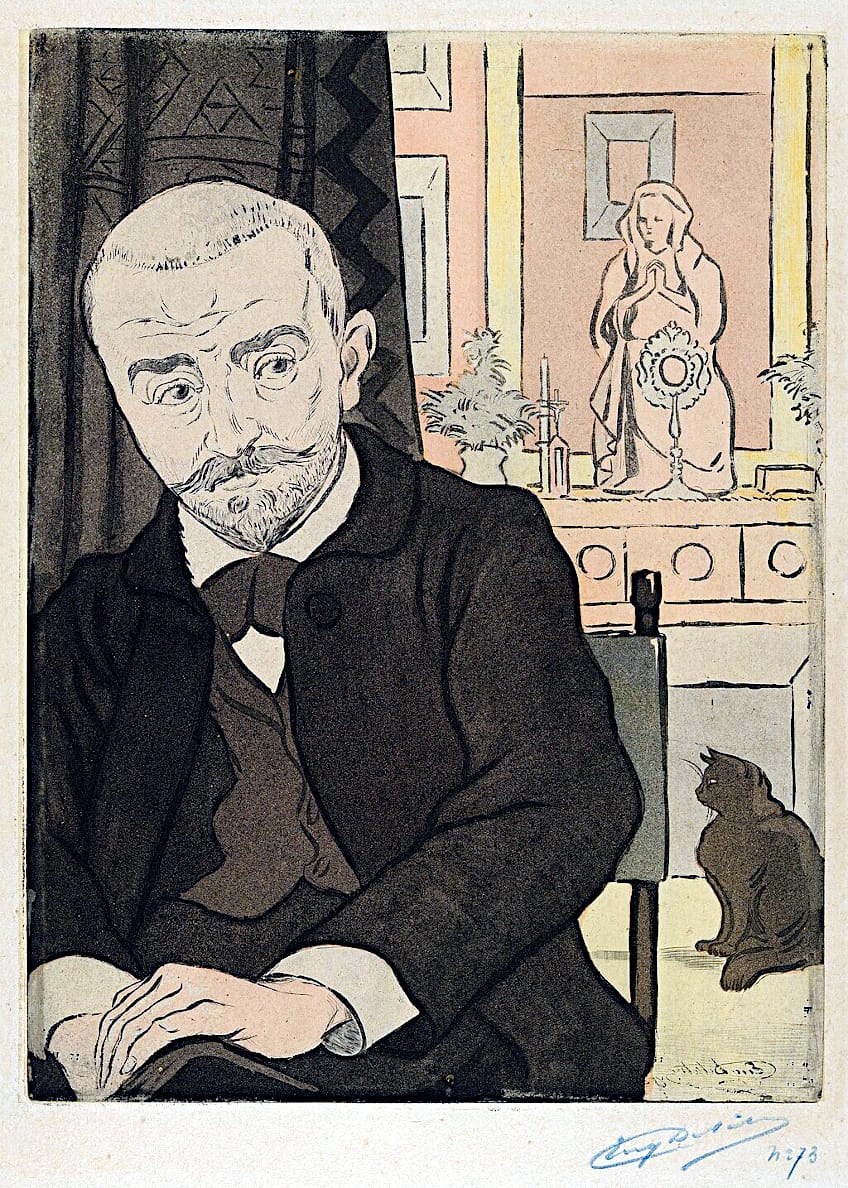
The fin de siècle atmosphere of the time also incited artists and writers to explore subjects around sexuality, idealism, mysticism, and avant-garde art due to the collective awareness around the ending of a century in Paris and its transition into the modern 20th century.
French art critic and novelist Joséphin Péladan was also a key figure in Rosicrucianism and universal Catholicism who pioneered a series of Salon exhibitions, which were inspired by the secret society known as the Salon de la Rose + Croix. Many Symbolist painters were associated with the Salon and included presentations on Avant-Garde art, music, and writing of the final decade of the 19th century.
Famous Symbolist Artworks
Now that you have more information on the different factors that influenced the Symbolist movement, you can now enjoy some of the most famous Symbolism art examples to help visualize the themes of Symbolism as well as the brilliant artists behind them.
The Eye Like a Strange Balloon Mounts Toward Infinity (1882) by Odilon Redon
| Artist Name | Odilon Redon (1840 – 1916) |
| Date | 1882 |
| Medium | Lithograph |
| Dimensions (cm) | 26.3 x 19.8 |
| Where It Is Housed | Museum of Modern Art, New York City, United States |
This cryptic lithograph was created by Odilon Redon, who was a prominent figure of the Symbolist movement. It is believed that Redon was inspired by the writings of Edgar Allen Poe and was not entirely an illustration related to any of his specific works, but rather, a concept that ran parallel to Poe’s writings.

Redon makes use of the all-seeing eye of God, which rises out of a swamp landscape and appears quite ominous. The eye carries a skull, representative of the dead towards the sky, and toward the divine. The light emanating from the negative space in the print also evokes a sense of the supernatural, which reminds one of a premonition or vision associated with mysticism that the Symbolism movement included.
Redon was also driven by scientific materialism and evolutionary theories proposed by Charles Darwin. The technology of hot air balloons was also popular at the time and took center stage in this print as a personal manifestation of Redon’s private world.
Masks Confronting Death (1888) by James Ensor
| Artist Name | Baron James Sidney Edouard Ensor (1860 – 1949) |
| Date | 1888 |
| Medium | Oil on canvas |
| Dimensions (cm) | 81.3 x 100.3 |
| Where It Is Housed | Museum of Modern Art, New York City, United States |
James Ensor was one of the best-known symbolist painters of the 19th century, who was inspired by his mother’s souvenir shop, which also sold papier mache masks for carnivals. The masks were a symbol of a return to his native country and thus representative of cultural unity through carnival aesthetics and the commercial and tourist elements of such events in the middle of industrialization. Ensor was best known for evoking the grotesque and obscure in his art and reminds one of the fantastical works of Hieronymus Bosch and the whimsical qualities of Pieter Bruegel.
Ensor’s work was also an important precursor to the Expressionist movement of the 20th century when many artists started to explore the depths of the human psyche.
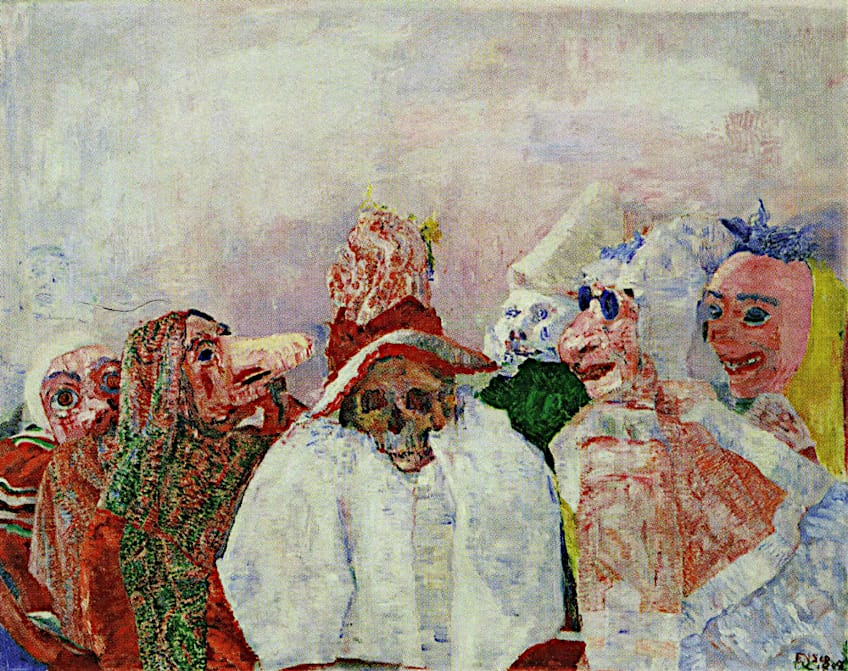
The Three Brides (1893) by Jan Toorop
| Artist Name | Johannes Theodorus ‘Jan’ Toorop (1858 – 1928) |
| Date | 1893 |
| Medium | Chalk, pencil, and charcoal on paper |
| Dimensions (cm) | 78 x 98 |
| Where It Is Housed | The Kröller-Müller Museum, Otterlo, Netherlands |
The Three Brides by Jan Toorop is one of the most famous Symbolist paintings of the fin de siècle decade and represents the three states of the soul, embodied by the three bridal figures. The bride in the center represents the innocence of the soul and is presented as torn between two worlds: the spiritual and the evil world, as embodied by the two brides on her left and right side. The bride on the left was painted in a Madonna-like fashion to allude to spirituality and the “goodness” of religion. The bride on the right is donning a skull garland, which represents the evil state of the soul.
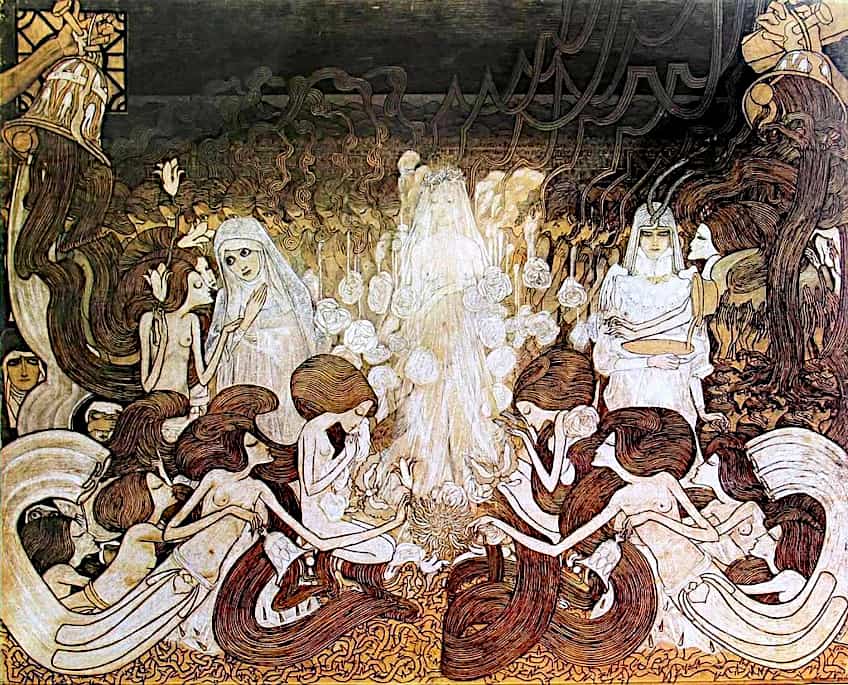
Other symbols are also seen in the composition such as a bed of thorns, which stresses the challenges of existence, and a symbol of passion, represented by the vessel of blood. Toorop’s paintings are incredibly profound as his use of symbolism differs from other famous symbolists of his time since he derived his mystical influences from non-Western sources. This can be seen in the elongated arms of the brides’ assistants who are scattered in the foreground and are believed to have been based on Javanese puppet theater productions.
Another point worth noting is that Toorop’s work also reflected the state of the visual arts and writings of women in spirituality as the source of evil itself, which was associated with procreation, sin, and sex. These subjects were regarded as taboo and can be understood today as a disillusioned sense of spirituality and perhaps a reflection of a collective hatred towards women stemming from a hatred of self.
Jupiter et Sémélé (1894 – 1895) by Gustave Moreau
| Artist Name | Gustave Moreau (1826 – 1898) |
| Date | 1894 – 1895 |
| Medium | Oil on canvas |
| Dimensions (cm) | 213 x 118 |
| Where It Is Housed | Musée National Gustave-Moreau, Paris, France |
Jupiter et Sémélé is a famous Symbolist painting by one of the pioneering Symbolist painters of the 19th century, Gustave Moreau, whose approach included a combination of many intricate and symbolic images. The painting is a scene from classical mythology where the mortal woman, Semele, was visited by her lover, Jupiter, at the request of Jupiter’s wife Juno. When Jupiter appeared in front of Semele, she was unfortunately struck by his lightning and was thus a symbol of their love, made divine through Semele’s intense and untimely death.
The imagery and symbolic expression of Jupiter and Semele’s love were also viewed as the “ultimate expression of an orgasm” with Moreau stating that Semele was purified in the process and with her death came the death of earthly love.
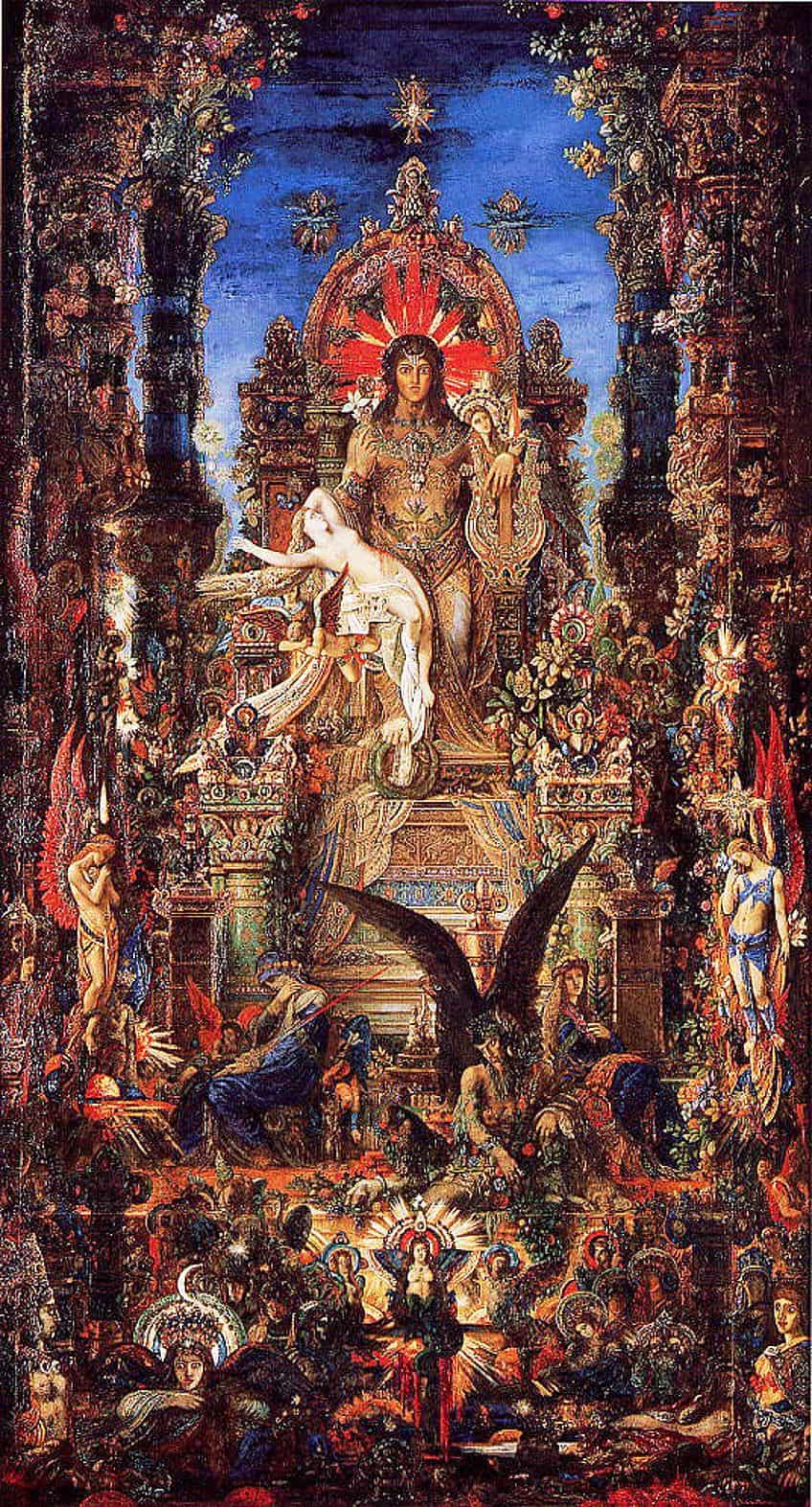
Le Réveil, Her Mother’s Kiss (1899) by Eugène Carrière
| Artist Name | Eugène Anatole Carrière (1849 – 1906) |
| Date | 1899 |
| Medium | Oil on canvas |
| Dimensions (cm) | 94 x 120 |
| Where It Is Housed | Pushkin Museum, Moscow, Russia |
This ethereal Symbolist painting was created by Eugène Carrière at the turn of the 19th century, just before his death. Le Réveil, A Mother’s Kiss is one such painting that includes Carrière’s wife and daughter, who share an endearing embrace and feature frequently in his portfolio. Carrière’s paintings fell into the collection of the city of Moscow and have since remained one of the most iconic Symbolist paintings to date.
Carrière’s unique monochromatic approach to painting and his use of brown and neutral shades in his work became his signature in Symbolism. Carrière was influenced by Jean-Jacques Henner as well as many other “old master” artists.
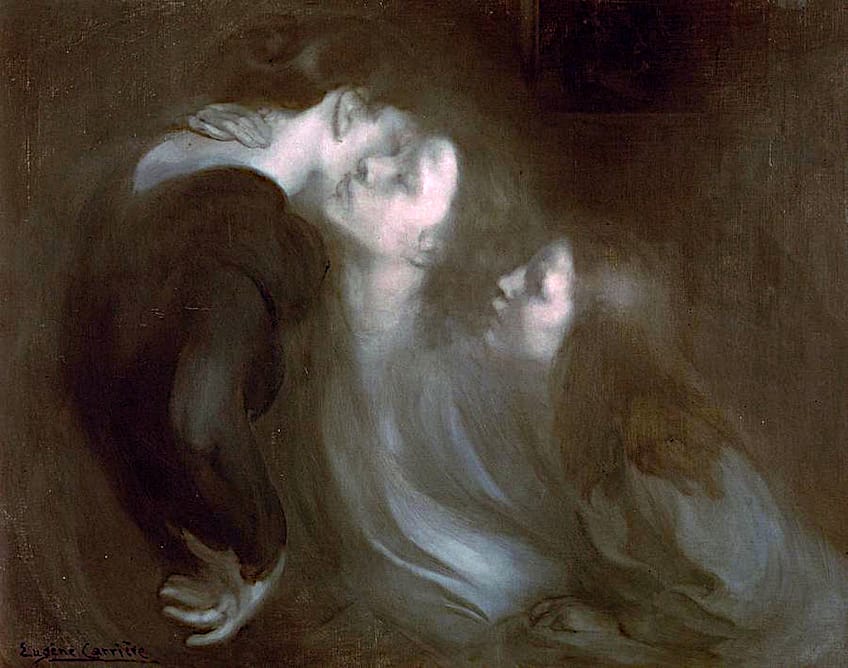
The hazy brown atmosphere in most of his works is what makes his paintings so nostalgic and highlights his view of the family as a “microcosm of mankind”.
Although he chose to represent close family members, Carrière focused on universal topics that reflect his idea of how inner family relations are connected to the external environment and can be used to learn valuable life lessons. The emphasis on connection is thus drawn out and remains a key component of Carrière and his exploration of symbolic forms through family relations.
The Dance of Life (1899 – 1900) by Edvard Munch
| Artist Name | Edvard Munch (1863 – 1944) |
| Date | 1899 – 1900 |
| Medium | Oil on canvas |
| Dimensions (cm) | 125 x 191 |
| Where It Is Housed | National Gallery, Oslo, Norway |
The Dance of Life is a popular Symbolist painting by Edvard Munch, who is commonly associated with the Expressionist movement and is among one of the most famous artists who used Symbolism. In The Dance of Life, Munch explores the experience of women perceived through three stages: the virgin, the woman in red, and the elderly woman who is presented as “satanic”. The ocean represents the unknown aspects of life, the notion of eternity, and death, which is held back temporarily. The dance represents the broader notion of earthly life while the solitary female figure in the background is seen stationed in front of a Freudian phallic symbol.

Other scenes in the painting show many male figures hovering above a woman dressed in white while another figure identified as Gunnar Heiberg is seen grabbing a woman out of lust. Tulla Larsen was Munch’s long-term lover and was introduced to Munch by Heiberg. It is believed that Munch was jealous of Heiberg and can be seen represented by the couple in the painting, who appear connected but bear distant expressions on their faces.
The theme of alienation and isolation in Munch’s painting was influenced by Arthur Schopenhauer whose philosophy was quite pessimistic. Munch highlights the couple’s seemingly “sealed fate” since the two never married or had children yet their connection was somewhat eternal due to the nature of society at the time, which was influenced by the effects of modernization.
Other Key Artists of Symbolism
Symbolism was a movement that spread across the globe and practiced by many talented artists. A few other key Symbolist painters and artists to take note of include creatives such as Mikhail Vrubel, Paul Gauguin, Hugo Simberg, Lascăr Vorel, Alfred Kubin, Anselmo Bucci, Henri Fantin-Latour, Emil Nolde, Franz von Stuck, and Gustav-Adolf Mossa among many others.
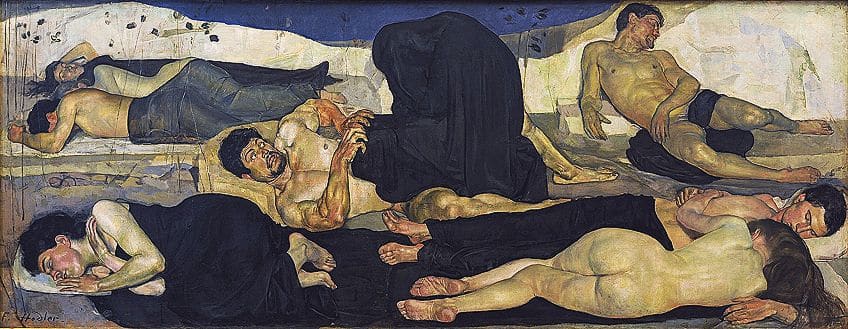
The Symbolism movement captured many important questions of the period that were ignited by the issues of modernization and the process of industrialization across Western Europe. Issues of isolation and outlets of art, philosophy, spirituality, and literature were solutions to 19th-century creatives, which encouraged personal expression and highlighted the growing need for an evaluation of the human psyche. These important themes are very much relatable to society today, which witnesses constant change and technological development that not only creates a degree of alienation, but also alters the modern human psyche.
Take a look at our symbolism painting webstory here!
Frequently Asked Questions
What Is Symbolism in Art?
Symbolism in art refers to an international art movement inspired by the transition of Western Europe into modern culture brought about by industrialization, and an escape away from the harsh realities of modernization. Symbolism was an exploration of Idealism and was also inspired by philosophies from Hermeticism and Parnassianism, as well as spirituality, religion, mysticism, and the use of symbols in art to relay messages about society and acknowledge the turn of a century.
Who Was the Most Influential Symbolist Painter?
The most influential painter of the Symbolist movement is considered to be French artist Gustave Moreau, who created more than 15,000 artworks covering allegory, biblical, and mythological subjects.
What Are the Primary Themes of Symbolism in Art?
The primary themes of Symbolism in art include mythology, sex, and death, which also made its appearance in literature and poetry. Other prominent symbolist themes included the use of metaphors, allegories, archetypes, personification, metonymy, irony, and hyperbole to express taboo and Contemporary observations about 19th century Western-European society.
Liam Davis is an experienced art historian with demonstrated experience in the industry. After graduating from the Academy of Art History with a bachelor’s degree, Liam worked for many years as a copywriter for various art magazines and online art galleries. He also worked as an art curator for an art gallery in Illinois before working now as editor-in-chief for artfilemagazine.com. Liam’s passion is, aside from sculptures from the Roman and Greek periods, cave paintings, and neolithic art.
Learn more about Liam Davis and about us.
Cite this Article
Liam, Davis, “Symbolism Art – Development of the Symbolist Movement.” artfilemagazine – Your Online Art Source. July 6, 2023. URL: https://artfilemagazine.com/symbolism-art/
Davis, L. (2023, 6 July). Symbolism Art – Development of the Symbolist Movement. artfilemagazine – Your Online Art Source. https://artfilemagazine.com/symbolism-art/
Davis, Liam. “Symbolism Art – Development of the Symbolist Movement.” artfilemagazine – Your Online Art Source, July 6, 2023. https://artfilemagazine.com/symbolism-art/.



